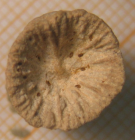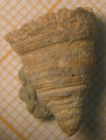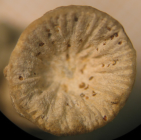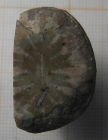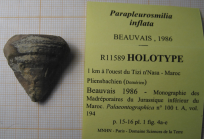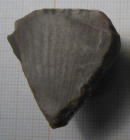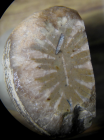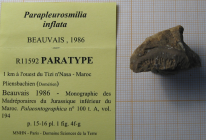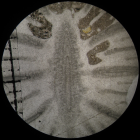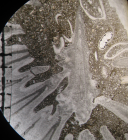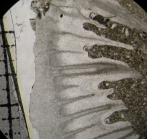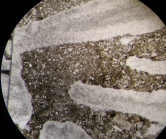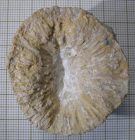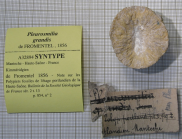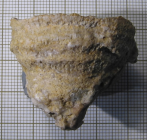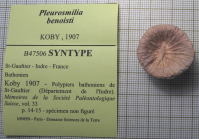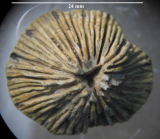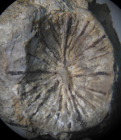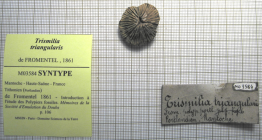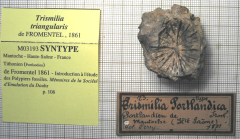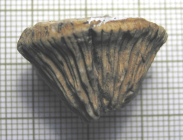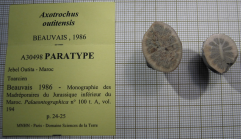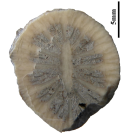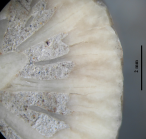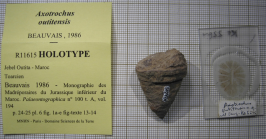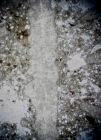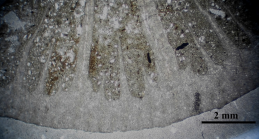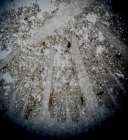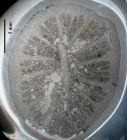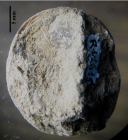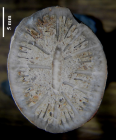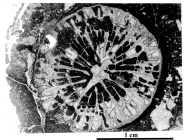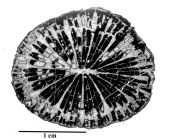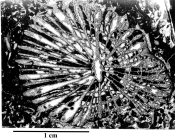WoRMS taxon details
Axosmilia Milne Edwards & Haime, 1848 †
1437933 (urn:lsid:marinespecies.org:taxname:1437933)
accepted
Genus
Caryophyllia extinctorium Michelin, 1840 † accepted as Axosmilia extinctorium (Michelin, 1840) † (type by original designation)
Axotrochus L. Beauvais, 1986 † · unaccepted > junior subjective synonym
Miscellosmilia Eliášová, 1976 † · unaccepted > junior subjective synonym
Parapleurosmilia L. Beauvais, 1986 † · unaccepted > junior subjective synonym
Pleurosmilia de Fromentel, 1856 † · unaccepted > junior subjective synonym
Trismilia de Fromentel, 1861 † · unaccepted > junior subjective synonym
- Species Axosmilia almerai de Angelis d'Ossat, 1905 †
- Species Axosmilia amellagouensis Vasseur & Lathuilière, 2021 †
- Species Axosmilia bofilli de Angelis d'Ossat, 1905 †
- Species Axosmilia carrapateirensis (Koby, 1904) †
- Species Axosmilia cellulosa (Koby, 1904) †
- Species Axosmilia craginiana (Wells, 1933) †
- Species Axosmilia crassa (Milaschewitsch, 1876) †
- Species Axosmilia cuneata (Koby, 1904) †
- Species Axosmilia discoidea (Koby, 1904) †
- Species Axosmilia duncani (Koby, 1904) †
- Species Axosmilia extinctorium (Michelin, 1840) †
- Species Axosmilia famosa (Eliášová, 1976) †
- Species Axosmilia felixi (Koby, 1904) †
- Species Axosmilia graciosa (de Fromentel, 1856) †
- Species Axosmilia grandis (de Fromentel, 1856) †
- Species Axosmilia hidesimaensis (Eguchi, 1951) †
- Species Axosmilia inflata (L. Beauvais, 1986) †
- Species Axosmilia irradians (de Fromentel, 1856)
- Species Axosmilia kayasakai Eguchi, 1951 †
- Species Axosmilia kobyi (de Angelis d'Ossat, 1905) †
- Species Axosmilia marcou (Étallon, 1859) †
- Species Axosmilia milaschewitschi (Koby, 1904) †
- Species Axosmilia multiradita Milne Edwards & Haime, 1848 †
- Species Axosmilia outitensis (L. Beauvais, 1986) †
- Species Axosmilia pumila (Koby, 1888) †
- Species Axosmilia quaylei (Wells, 1933) †
- Species Axosmilia renevieri (Koby, 1896) †
- Species Axosmilia saxifisi (Wells, 1933) †
- Species Axosmilia stutzi (Koby, 1896) †
- Species Axosmilia tenuistriata (Koby, 1904) †
- Species Axosmilia triangularis (Fromentel, 1861) †
- Species Axosmilia truncata (Koby, 1880) †
- Species Axosmilia turbinata (Goldfuss, 1833) †
- Species Axosmilia vaughani (de Angelis d'Ossat, 1905) †
- Species Axosmilia villersensis (Koby, 1898) †
- Species Axosmilia volxi (de Angelis d'Ossat, 1905) †
- Species Axosmilia whitneyi (Wells, 1933) †
- Species Axosmilia cylindrica Prever, 1909 † accepted as Trochoidomeandra cylindrica (Prever, 1909) † (unaccepted > superseded combination, basionym)
- Species Axosmilia fritillus (de Fromentel & de Ferry, 1866) † accepted as Stylophyllopsis fritillus (de Fromentel & de Ferry, 1866) † (unaccepted > superseded combination)
- Species Axosmilia wrighti Milne Edwards & Haime, 1851 † accepted as Donacosmilia wrighti (Milne Edwards & Haime, 1851) † (basionym, changed combination)
- Species Axosmilia alpina Loretz, 1875 † (uncertain > unassessed)
marine, fresh, terrestrial
fossil only
Milne Edwards, H.; Haime, J. (1848). Observations sur les Polypiers de la famille des Astréides. <em>Comptes Rendus de l'Académie Des Sciences, Paris.</em> 27: 465–470. [details]
Description Solitary corallum, attachment area absent or very small. Calicular platform generally infundibuliform, occasionally flat...
Description Solitary corallum, attachment area absent or very small. Calicular platform generally infundibuliform, occasionally flat and more rarely a little convex. Calice elliptical. "Epitheca" or external coating folded, Costae short, unequal, unornamented, corresponding to septa. Radial elements are compact bicuneiform costosepta, generally free and straight, sometimes curved according to the bilateral plan. They are very regularly arranged in cyles according to their length and their thickness with shorter S1 placed in the dorso-ventral plan. A first cycle septum can be linked to the columella according to the bilateral plan. Some of the last cycle septa may also anastomose to major septa Lateral faces display unequal granules, randomly arranged. Thick septa smoother. Distal margin weakly ornamentated mainly characterised by a zigzag pattern in thinner septa. On transverse sections, the internal margin displays no denticulation. Microstructure characterised by a zigzag mid-septal line which gives birth to a microarchitecture marked by zigzag shaped young septa and by randomly arranged granules in older septa. Original microarchitecture progressively smoothed during growth by addition of laminar layers, firstly in the wall region and secondarily nearby the internal edge. Columella essential, lamellar and continuous with a microarchitecture similar to septa. It is surrounded by a small groove. In depth it is connected with a S1 and then to other septa in the deepest part of the corallite. Endotheca made of few large vesiculous dissepiments distally convex in the outer part and of dissepiments (or tabulae ?) perhaps more distally concave nearby the columella. Wall made up by the enlargement of costae, itself induced by the development of laminar layers of the stereome which are in continuity with thickened dissepiments. The place of the wall does not coincide with the largest thickness of costo-septa. No palus; no synapticule. [details]
Hoeksema, B. W.; Cairns, S. (2024). World List of Scleractinia. Axosmilia Milne Edwards & Haime, 1848 †. Accessed through: World Register of Marine Species at: https://www.marinespecies.org/aphia.php?p=taxdetails&id=1437933 on 2024-06-06
Date
action
by
![]() The webpage text is licensed under a Creative Commons Attribution 4.0 License
The webpage text is licensed under a Creative Commons Attribution 4.0 License
original description
Milne Edwards, H.; Haime, J. (1848). Observations sur les Polypiers de la famille des Astréides. <em>Comptes Rendus de l'Académie Des Sciences, Paris.</em> 27: 465–470. [details]
original description (of Axotrochus L. Beauvais, 1986 †) Beauvais L. (1986). Monographie des madréporaires du Jurassique inférieur du Maroc. <em>Palaeontographica (A).</em> 194 (1/3): 1–68. [details]
original description (of Pleurosmilia de Fromentel, 1856 †) Fromentel E. de. (1856). Note sur les polypiers fossiles de l'étage portlandien de la Haute-Saône. <em>Bulletin de la Société géologique de France, Série 2,.</em> 3: 851–865. [details]
original description (of Parapleurosmilia L. Beauvais, 1986 †) Beauvais L. (1986). Monographie des madréporaires du Jurassique inférieur du Maroc. <em>Palaeontographica (A).</em> 194 (1/3): 1–68. [details]
original description (of Miscellosmilia Eliášová, 1976 †) Eliášová H. (1976). Familles Placosmiliidae Alloiteau, 1952 et Misistellidae nov. fam.(Hexacorallia) des calcaires de Štramberk (Tithonien, Tchécoslovaquie). <em>Časopis pro Mineralogii a Geologii.</em> 21(4): 337-347, pls. 1-10. [details]
original description (of Trismilia de Fromentel, 1861 †) Fromentel, E. de. (1861). Introduction a l'etude des polypiers fossiles. <em>Memoires de la Societe d 'Emulation du Departement du Doubs.</em> 1-157. [details]
basis of record Milne Edwards H, Haime J. (1857). Histoire naturelle des coralliaires ou polypes proprement dits 2. Librairie Encyclopédique de Roret, Paris. 631 pp., available online at https://www.biodiversitylibrary.org/page/12403706 [details]
additional source Duncan PM (1884) A revision of the families and genera of the sclerodermic Zoantharia, Ed. & H., or Madreporaria (M. Rugosa excepted). Journal of the Linnean Society of London, 18: 1-204. [details]
additional source Vasseur, R., Lathuilière, B. (2021). Pliensbachian corals from the Western Tethys. <em>Geodiversitas.</em> 43(22): 1187-1291., available online at https://doi.org/10.5252/geodiversitas2021v43a22 [details]
original description (of Axotrochus L. Beauvais, 1986 †) Beauvais L. (1986). Monographie des madréporaires du Jurassique inférieur du Maroc. <em>Palaeontographica (A).</em> 194 (1/3): 1–68. [details]
original description (of Pleurosmilia de Fromentel, 1856 †) Fromentel E. de. (1856). Note sur les polypiers fossiles de l'étage portlandien de la Haute-Saône. <em>Bulletin de la Société géologique de France, Série 2,.</em> 3: 851–865. [details]
original description (of Parapleurosmilia L. Beauvais, 1986 †) Beauvais L. (1986). Monographie des madréporaires du Jurassique inférieur du Maroc. <em>Palaeontographica (A).</em> 194 (1/3): 1–68. [details]
original description (of Miscellosmilia Eliášová, 1976 †) Eliášová H. (1976). Familles Placosmiliidae Alloiteau, 1952 et Misistellidae nov. fam.(Hexacorallia) des calcaires de Štramberk (Tithonien, Tchécoslovaquie). <em>Časopis pro Mineralogii a Geologii.</em> 21(4): 337-347, pls. 1-10. [details]
original description (of Trismilia de Fromentel, 1861 †) Fromentel, E. de. (1861). Introduction a l'etude des polypiers fossiles. <em>Memoires de la Societe d 'Emulation du Departement du Doubs.</em> 1-157. [details]
basis of record Milne Edwards H, Haime J. (1857). Histoire naturelle des coralliaires ou polypes proprement dits 2. Librairie Encyclopédique de Roret, Paris. 631 pp., available online at https://www.biodiversitylibrary.org/page/12403706 [details]
additional source Duncan PM (1884) A revision of the families and genera of the sclerodermic Zoantharia, Ed. & H., or Madreporaria (M. Rugosa excepted). Journal of the Linnean Society of London, 18: 1-204. [details]
additional source Vasseur, R., Lathuilière, B. (2021). Pliensbachian corals from the Western Tethys. <em>Geodiversitas.</em> 43(22): 1187-1291., available online at https://doi.org/10.5252/geodiversitas2021v43a22 [details]
 Present
Present  Inaccurate
Inaccurate  Introduced: alien
Introduced: alien  Containing type locality
Containing type locality
From editor or global species database
Description Solitary corallum, attachment area absent or very small. Calicular platform generally infundibuliform, occasionally flat and more rarely a little convex. Calice elliptical. "Epitheca" or external coating folded, Costae short, unequal, unornamented, corresponding to septa. Radial elements are compact bicuneiform costosepta, generally free and straight, sometimes curved according to the bilateral plan. They are very regularly arranged in cyles according to their length and their thickness with shorter S1 placed in the dorso-ventral plan. A first cycle septum can be linked to the columella according to the bilateral plan. Some of the last cycle septa may also anastomose to major septa Lateral faces display unequal granules, randomly arranged. Thick septa smoother. Distal margin weakly ornamentated mainly characterised by a zigzag pattern in thinner septa. On transverse sections, the internal margin displays no denticulation. Microstructure characterised by a zigzag mid-septal line which gives birth to a microarchitecture marked by zigzag shaped young septa and by randomly arranged granules in older septa. Original microarchitecture progressively smoothed during growth by addition of laminar layers, firstly in the wall region and secondarily nearby the internal edge. Columella essential, lamellar and continuous with a microarchitecture similar to septa. It is surrounded by a small groove. In depth it is connected with a S1 and then to other septa in the deepest part of the corallite. Endotheca made of few large vesiculous dissepiments distally convex in the outer part and of dissepiments (or tabulae ?) perhaps more distally concave nearby the columella. Wall made up by the enlargement of costae, itself induced by the development of laminar layers of the stereome which are in continuity with thickened dissepiments. The place of the wall does not coincide with the largest thickness of costo-septa. No palus; no synapticule. [details]Remark The lectotype of the type-species is rather badly preserved and the species is rare in the type area and generally in the Bajocian. So the name of Axosmilia is kept only because C. extinctorium is compatible with better preserved Upper Jurassic or Cretaceous specimens classified as Axosmilia or Pleurosmilia. Several tens of nominal Jurassic (Lathuilière 1989) and Cretaceous (Loeser 2000) species initially attributed to various genera are in need of a revision. [details]
From editor or global species database
Image from synonym
Image from synonym
Image from synonym
Image from synonym
Image from synonym
Image from synonym
Image from synonym
Image from synonym
Image from synonym
Image from synonym
Image from synonym
Image from synonym
Image from synonym
Image from synonym
Image from synonym
Image from synonym
Image from synonym
Image from synonym
Image from synonym
Image from synonym
Image from synonym
Image from synonym
Image from synonym
Image from synonym
Image from synonym
Image from synonym
Image from synonym
Image from synonym
Image from synonym
Image from synonym
Image from synonym
Image from synonym
Image from synonym
Image from synonym
Image from synonym
Image from synonym
Image from synonym
Image from synonym
Image from synonym
